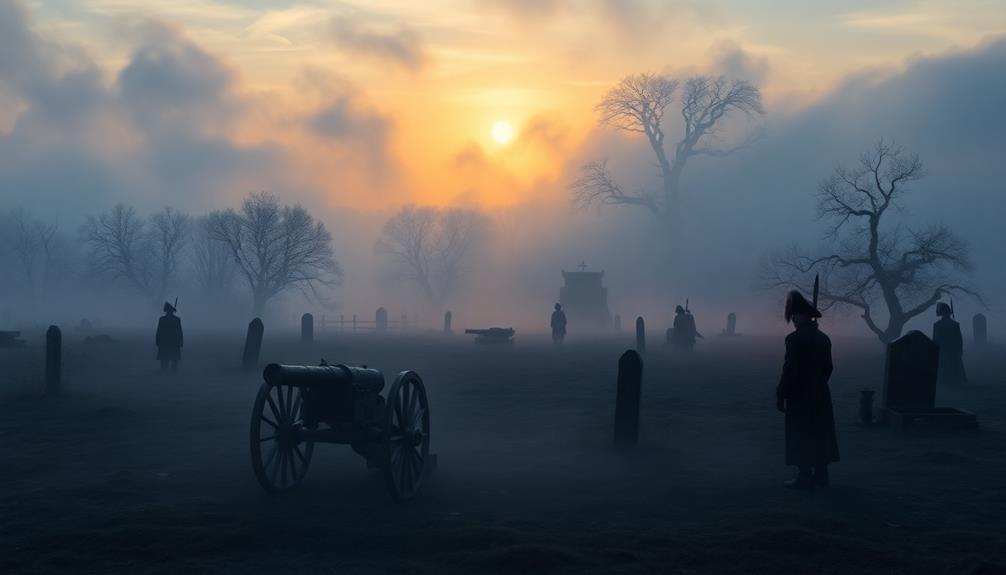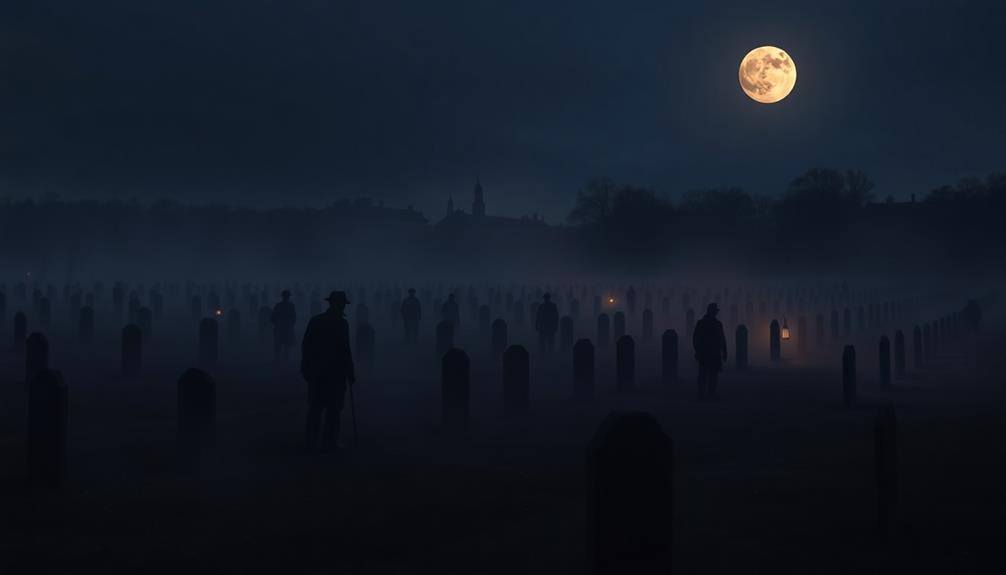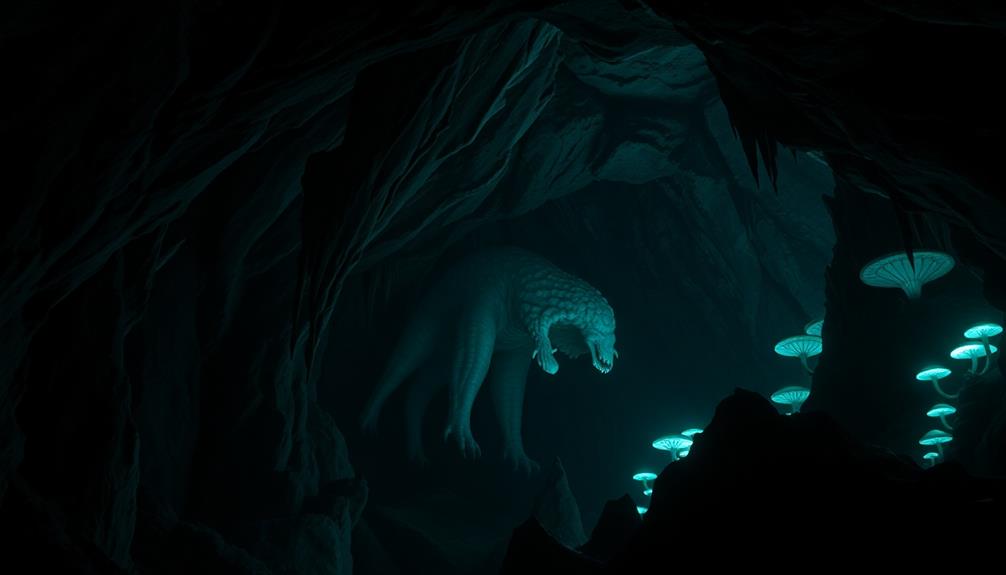In Gettysburg, history and hauntings collide in a uniquely chilling way. As you explore the battlefield, you'll encounter the spirits tied to the Civil War's tragic past. Notable ghost sightings include the "Lady in White" searching for her lost love and phantom soldiers wandering sites like Pickett's Charge. The Jennie Wade House, where the only civilian casualty fell, holds its own eerie presence, bringing her story to life. Guided ghost tours transport you through haunted locales, unearthing gripping tales. Stick around to uncover even more of Gettysburg's spectral secrets and the stories that forged its haunted reputation.
Key Takeaways
- Gettysburg's tragic Civil War history, marked by immense loss, has led to numerous ghost stories and reported hauntings in the area.
- The legend of Jennie Wade, the only civilian killed in the battle, embodies the haunting spirit of Gettysburg's past.
- Iconic locations like the Farnsworth House and Triangular Field are renowned for ghost sightings and eerie phenomena related to the battlefield's history.
- Visitors often experience strange sounds, apparitions, and electronic malfunctions while exploring haunted sites, deepening their connection to the past.
- Guided ghost tours provide insights into local legends and paranormal investigations, merging historical narratives with supernatural experiences in Gettysburg.
Overview of Ghost Stories
Ghost stories have long captivated audiences with their eerie allure and chilling narratives. These tales often revolve around themes of haunting, where spirits linger in specific places or are tied to particular objects and individuals. They reflect societal fears and cultural anxieties that have persisted throughout history. From classical literature like Homer's "Odyssey" to contemporary narratives, the tradition of ghost stories spans all cultures, transmitted orally or in written form.
During the English Renaissance Theatre, ghostly figures gained prominence, with characters like Hamlet's ghost shaping how spectral beings are portrayed in literature and drama. The Golden Age of the Ghost Story, from the 1830s to World War I, introduced unforgettable authors like Edgar Allan Poe and Sheridan Le Fanu, who crafted chilling narratives that still resonate today.
What makes ghost stories compelling is their specific narrative structure, engaging readers through horror, psychological tension, and even romantic themes. These elements help you explore the complexities of human emotions, drawing you into the haunted worlds they create.
Historical Significance of Gettysburg

Gettysburg wasn't just a battlefield; it marked a critical turning point in the Civil War that shaped the nation's future.
You'll find stories of remarkable figures like Jennie Wade, whose tragic death symbolizes the human cost of the conflict.
Understanding these events helps you grasp the profound historical significance of Gettysburg in American history.
Civil War Battle Impact
The Battle of Gettysburg stands as a monumental event in American history, marking a significant turning point in the Civil War. Fought from July 1-3, 1863, this battle was the largest land confrontation in the Western Hemisphere, with approximately 7 million bullets fired. The staggering toll included over 10,000 soldiers killed and 25,000 wounded, making it the bloodiest battle of the Civil War.
The sheer volume of violent deaths left an indelible mark on the battlefield, now recognized as one of the deadliest battlegrounds in history. The strategic implications for both Union and Confederate forces reshaped military tactics and influenced subsequent engagements.
As you walk through the solemn grounds, you can feel the weight of history; the legacy of Gettysburg permeates American culture and narratives.
Interestingly, the tragic loss of life, with many soldiers buried in mass graves, contributes to the area's reputation for paranormal activity. Visitors often report ghost sightings, hinting at the lingering presence of those who fought bravely during this pivotal conflict.
The echoes of the past remind you that history and hauntings coexist in this hallowed ground.
Jennie Wade's Tragic Death
Amidst the chaos of the Battle of Gettysburg, the story of Jennie Wade stands as a poignant reminder of the war's far-reaching impact on civilians. On July 3, 1863, at just 20 years old, Jennie became the only non-combatant killed during the battle when a stray bullet struck her while she was baking bread for Union soldiers. Her tragic death in her sister's home highlights the vulnerability of local civilians amid the violent conflict.
Consider the deeper implications of Jennie's fate:
- Her death symbolizes the collateral damage of war, affecting innocent lives.
- Jennie's grave in Gettysburg National Cemetery has become a pilgrimage site, reflecting her enduring legacy.
- The legend of the "Lady in White" adds a haunting dimension, as she reportedly wanders the battlefield searching for lost loved ones.
Jennie Wade's story is more than a tale of tragedy; it's a stark reminder that the brutal realities of war extend beyond the battlefield, leaving lasting scars on communities and families.
Through her legend, we confront the human cost of conflict, ensuring that her memory endures amidst the echoes of history.
Notable Historical Figures
Historians often highlight the pivotal roles played by key figures during the Battle of Gettysburg, underscoring the strategic decisions that shaped its outcome. Notable historical figures like Union Brig. Gen. Alexander Schimmelfennig and Maj. Gen. Daniel E. Sickles made significant impacts on the battlefield. Schimmelfennig's defense of Culps Hill proved crucial, providing the Union with a strategic advantage.
In contrast, Sickles' controversial choice to advance to the Peach Orchard exposed his troops, ultimately affecting the battle's dynamics.
Amidst the chaos, Jennie Wade stands out as a poignant figure; at just 20 years old, she became the only civilian casualty when a stray bullet struck her while she baked bread for the Union soldiers. Her tragic story adds a layer of humanity to the battlefield's history, making Gettysburg a haunted place steeped in memories.
These figures' legacies continue to influence Gettysburg's cultural memory, with numerous reports of their spirits lingering in the area. As you walk the battlefield, you may feel their presence, reminding you of the sacrifices made and the monumental decisions that defined this turning point in American history.
Notable Hauntings and Legends

When you explore Gettysburg, you might encounter the haunting presence of the Lady in White, eternally searching for her lost love.
Keep your ears open for the sounds of phantom soldiers marching, as they evoke the battlefield's tragic past.
You may also feel the sorrowful energy of Jennie Wade's spirit, a reminder of the civilian lives forever changed by the war.
The Lady in White
The legend of the Lady in White captivates many who visit Gettysburg, drawing them into her haunting tale. She's often seen wandering the fields and near the Gettysburg National Cemetery, her glowing white dress fluttering in the breeze.
Believed to be searching for her lost beloved from the Civil War, her presence evokes profound feelings of sorrow and melancholy. Visitors frequently describe experiences that highlight her emotional connection to the historical events of the battlefield.
You might feel a chill or a wave of sadness wash over you as you catch a glimpse of this ethereal apparition.
Key aspects of the Lady in White's legend include:
- Symbol of Loss: She embodies the grief felt by countless families during the Civil War.
- Haunting Presence: Sightings contribute to Gettysburg's haunted reputation, attracting ghost hunters and history buffs alike.
- Connection to History: Her story intertwines with the very fabric of the town, reminding us of the past's lingering shadows.
As you explore Gettysburg, keep an eye out for this iconic figure, a poignant reminder of love and loss amidst the echoes of history.
Phantom Soldiers Sightings
As you wander the hallowed grounds of Gettysburg, you might encounter not only the sorrowful Lady in White but also the specters of soldiers who fought valiantly in the Civil War. Numerous ghost sightings have been reported, especially near Pickett's Charge and Devil's Den, where visitors often see soldiers in uniform and hear the distant sounds of battle.
One of the most haunted sites is the Valley of Death, where ghostly figures have been spotted walking among the gravestones in Gettysburg National Cemetery. You might also hear accounts of the Phantom Regiment, known for the eerie echoes of phantom drums and musket fire reverberating through the battlefield at night.
Don't overlook the Dobbin House, where the spirit of a Confederate soldier is said to linger alongside its original owner, Alexander Dobbin. Witnesses describe chilling encounters and mysterious bloodstains on the floorboards that vanish by daylight.
Whether you're a skeptic or a believer in the paranormal activity of this historic site, the stories of phantom soldiers add a fascinating layer to the rich tapestry of Gettysburg's haunted past.
Jennie Wade's Spirit
Jennie Wade's spirit lingers in the hearts and minds of those who visit Gettysburg, offering a poignant connection to the town's tragic past. At just 20, she became the only civilian casualty during the Battle of Gettysburg, shot while baking bread for Union soldiers.
Today, her haunted presence is felt at the Jennie Wade House, where visitors often report strange phenomena.
- Unexplained voices echo through the halls, invoking a sense of sorrow.
- Sightings of the Lady in White, often thought to be Jennie, roam the battlefield in search of her lost beloved.
- Paranormal investigations reveal apparitions and the chilling sound of a woman's voice calling out.
These experiences reflect the deep emotional ties to the Civil War and the impact of Jennie Wade's untimely death on local history.
When you step into the Jennie Wade House, you can almost feel her lingering spirit, a reminder of the human cost of war. Whether you're a believer in the paranormal or simply a history buff, the haunting legacy of Jennie Wade enriches your visit, connecting you to the enduring stories of those who lived—and died—during this tumultuous time.
Iconic Locations for Ghost Sightings

Gettysburg's haunted hotspots draw in thrill-seekers and history buffs alike, each location steeped in stories of spectral encounters.
One of the most famous is the Farnsworth House, where reports of at least 16 distinct spirits create an eerie atmosphere filled with unexplained sounds and sightings.
On your ghost tour, you can't miss the Jennie Wade House, the site of the only civilian death during the Battle of Gettysburg. Here, strange movements and disembodied voices echo through the halls, chilling visitors to the bone.
Another iconic spot is the Dobbin House, haunted by Alexander Dobbin's spirit and a Confederate soldier. Guests often report mysterious blood stains that vanish in daylight.
If you venture to Triangular Field, you'll find a high concentration of ghostly activity, with visitors experiencing camera malfunctions and witnessing apparitions of soldiers.
Paranormal Investigations and Evidence

Exploring the eerie landscape of Gettysburg, many visitors and paranormal investigators have encountered compelling evidence of ghostly activity. Reports of ghost sightings abound, especially near significant historical sites like Pickett's Charge and the Valley of Death.
These sightings often involve "intelligent hauntings," where apparitions interact with the living before disappearing, hinting at a deep connection to the battlefield's tragic past.
Paranormal investigations in Gettysburg have revealed fascinating findings, including:
- Electromagnetic emissions: Investigators track these anomalies, which often coincide with reported ghost sightings, supporting the idea of the battlefield as a "time camera."
- Geological influence: The area's unique granite and quartz formations are believed to hold energy, amplifying the hauntings linked to traumatic events.
- Time travel claims: Some individuals assert they've experienced interactions with the past, adding layers of intrigue to Gettysburg's haunted reputation.
As you explore the world of paranormal investigations here, it becomes clear that the ghosts of Gettysburg are more than mere folklore—they're a haunting reminder of history, beckoning you to investigate the echoes of time.
Visitor Experiences and Encounters

Witnessing ghostly figures in Gettysburg can be a spine-tingling experience, as many visitors recount encounters that blur the lines between history and the supernatural. At sites like Pickett's Charge and the Valley of Death, you might see apparitions of soldiers wandering silently, lost in time.
The Farnsworth Inn, a well-known haunted site, houses at least 16 distinct spirits. Guests often report hearing eerie sounds, including breathing, voices, and even music echoing through its halls.
You may also cross paths with the haunting Lady in White, an ethereal figure in a glowing dress, searching for her lost beloved from the Civil War. The Jennie Wade House, the site of the only civilian casualty during the battle, adds to the chilling tales with strange movements and unexplained voices that visitors often describe.
While exploring Triangular Field, be prepared for some odd occurrences; many visitors experience strange electronic malfunctions with their cameras and devices, coinciding with ghostly phenomena.
These visitor experiences contribute to Gettysburg's reputation as a place where the past lingers, making each encounter a memorable aspect of your journey through this haunted site.
Touring Gettysburg's Haunted Sites

As the sun sets over the hallowed grounds of Gettysburg, the thrill of adventure beckons you to commence on a haunted tour that weaves together rich history and eerie tales.
Your journey kicks off at the Brickhouse Inn, where your guide, easily identifiable in a US Ghost Adventures T-shirt and carrying a lantern, awaits to lead you through this spectral exploration.
Along the mile-long tour, you'll visit key historic sites steeped in the lore of the Civil War, including:
- Witness Tree: A living relic that's witnessed countless battles and ghostly sightings.
- Farnsworth House: Once a refuge during the war, it's now known for its haunting tales of the past.
- Jennie Wade's Spirit: Encounter her ghost as you learn about her tragic fate.
Expect to hear chilling accounts of ghostly soldiers and see remnants of the battles, like bullet holes still visible in the structures.
Don't forget to wear comfortable shoes and dress for the evening chill; this isn't just a tour of Gettysburg—it's a chance to connect with the echoes of history that linger in the night.
Cultural Impact of Ghost Stories

How do ghost stories shape our understanding of culture and history? They serve as mirrors, reflecting societal fears and anxieties across time. During the Golden Age of the Ghost Story, from the 1830s to WWI, authors like Edgar Allan Poe and Sheridan Le Fanu popularized this genre, embedding it deeply into our cultural narratives.
These tales have evolved, finding new life in contemporary media like "Ghost Whisperer" and the film "Ghost" (1990), showcasing their enduring relevance. Ghost stories often intertwine themes of love, loss, and the supernatural, as seen in various folklore traditions, such as Japanese Kaidan and British Border Ballads.
These narratives highlight the cultural significance of ghostly encounters, allowing societies to explore complex emotions and existential questions. Scholarly works and anthologies further enhance our understanding of ghost lore, revealing how different cultures interpret the supernatural.
Additionally, writers like Algernon Blackwood investigate the psychological aspects of fear and the unknown, illustrating cultural shifts in perception. Ultimately, ghost stories hold a profound cultural impact, enriching global storytelling traditions and shaping how we engage with history and our collective psyche.
Resources for Ghost Enthusiasts

For those enthusiastic to explore the supernatural side of Gettysburg, a wealth of resources awaits you. The Gettysburg Battlefield features a variety of ghost tours led by expert local guides who immerse themselves in the area's haunted history and share spine-tingling ghost sightings.
You can visit key haunted locations such as the Brickhouse Inn and Farnsworth House, both rich in historical significance.
To enhance your ghostly adventure, consider these resources:
- Join a ghost tour: Discover the legends and lore that surround Gettysburg, guided by knowledgeable locals.
- Participate in paranormal investigations: Engage in firsthand experiences that investigate the battlefield's eerie atmosphere and share your findings with fellow enthusiasts.
- Explore scholarly works: Read anthologies and studies that provide deeper insights into ghost lore and cultural perspectives on hauntings.
For inquiries about ghost tours and related events, you can reach out via phone at 877-680 (TOUR) or email info@gburgtours.com.
With these resources, you'll be well-equipped to navigate Gettysburg's haunted history and create unforgettable memories.
Frequently Asked Questions
What Was the Ghost in the Battle of Gettysburg?
You might encounter phantom soldiers in Civil War uniforms, marching and disappearing, or hear the Lady in White searching for her lost love. These spirits reflect the sorrow and loss from the Battle of Gettysburg.
Is the Dobbin House in Gettysburg Haunted?
Yes, the Dobbin House in Gettysburg is considered haunted. You might experience strange phenomena like disappearing blood stains, eerie sounds, and ghostly apparitions, all tied to its history as a field hospital during the battle.
What Are the Ghost Stories on the Sachs Covered Bridge?
You'll hear whispers of soldiers and see ghostly figures at the Sachs Covered Bridge. Many claim to witness a Confederate soldier lingering nearby, alongside eerie sounds of footsteps and distant cannon fire, especially on foggy nights.
Is the Federal Pointe Inn Haunted?
You'll find the Federal Pointe Inn has a reputation for hauntings. Guests often report ghostly figures, strange noises, and cold spots, especially in the hallways, making it a thrilling experience for those seeking the paranormal.
Conclusion
So, if you're ever in Gettysburg and feel a chill that's not just the brisk autumn air, don't panic—it's probably just a ghost wanting to share its war stories. After all, who wouldn't want to haunt a battlefield instead of an office cubicle? Immerse yourself in the spectral side of history, where the past lingers and spirits socialize. Just remember to ask before you snap that selfie; some ghosts really value their privacy!









